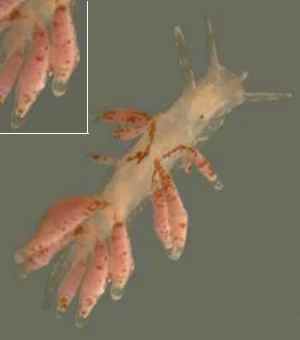Cuthona cf. poritophages from American Samoa
January 11, 2002
From: Don Barclay

Hi Bill,
Here's one for you that I'm not going to hazard a guess on. It is tiny, around 4mm long, and was found crawling on a coral branch (Porites cylindrica?) in less than one meter of water, ~1730 local time, 13 July 2001, middle of Coconut Point, Nu'uuli, American Samoa.
The cerata appeared to mostly be paired, with two growing from about the same spot on the body. The irregular brown markings on the body seem to connect the first two pairs of cerata on each side. The body itself is mostly transparent, with an opaque white area in the middle toward the head. Can you identify it?
Thanks again,
Don Barclay
n5ols@samoatelco.com
Barclay, D., 2002 (Jan 11) Cuthona cf. poritophages from American Samoa. [Message in] Sea Slug Forum. Australian Museum, Sydney. Available from http://www.seaslugforum.net/find/4823Dear Don,
This has many similarities to Cuthona poritophages which feeds exclusively on species of the coral genus Porites. At present it is known only from eastern Africa but there is no reason why it couldn't have a wider geographic range. There are obvious differences. However the lack of pigmentation in your animal, and the small number of cerata, could be because your animal is a small juvenile. Finding it on a coral suggests it could be a coral feeder, especially when at such a small size it would be most likely to find it on its food. There is another clue however. If you look at the tips of its cerata, you will see they are rounded and the tip seems to be lined with white glands. The nematocysts in corals seem to be unsuitable for use in defence by aeolids [see page on cnidosacs] and all coral-feeding aeolids have instead a swollen glandular tip to their cerata such as this animal [see Coral Feeding - defensive adaptations].
To be sure we would need to look at some larger animals and probably their anatomy.
Best wishes,
Bill Rudman.
Related messages
-
Cuthona poritophages - another coral-feeder
From: Bill Rudman, May 31, 1999
